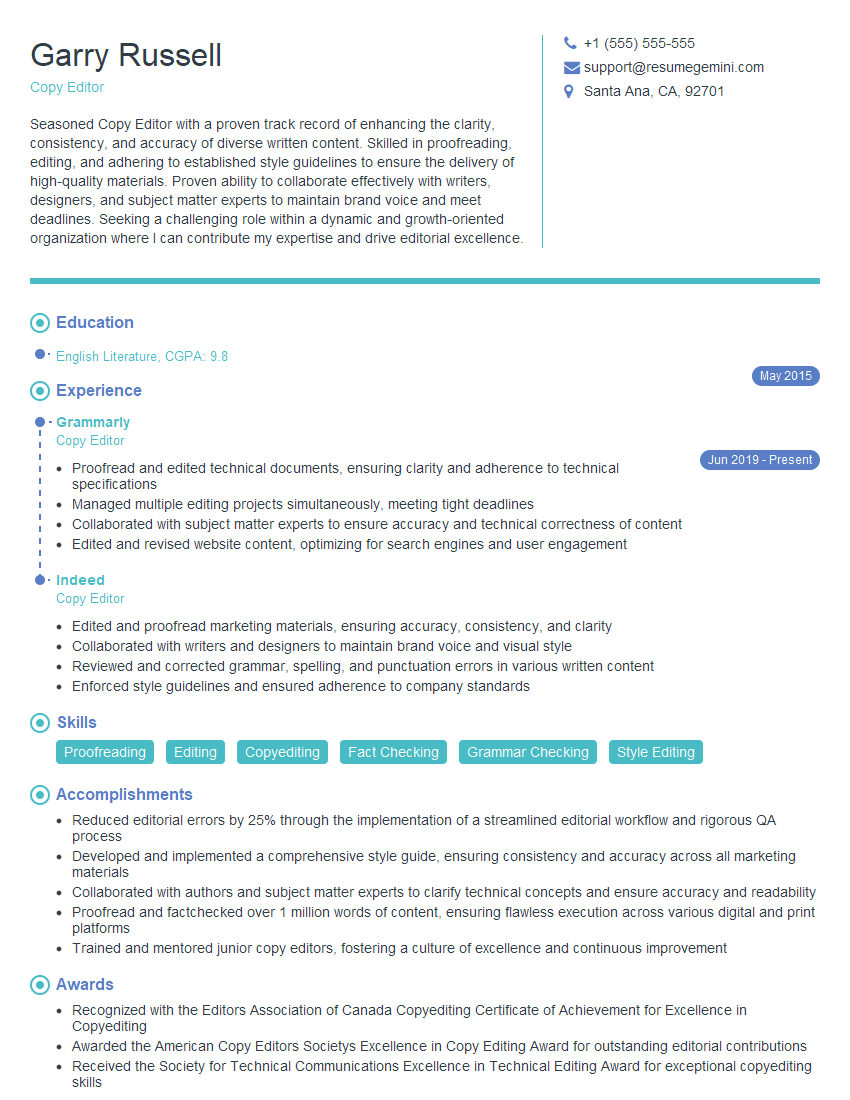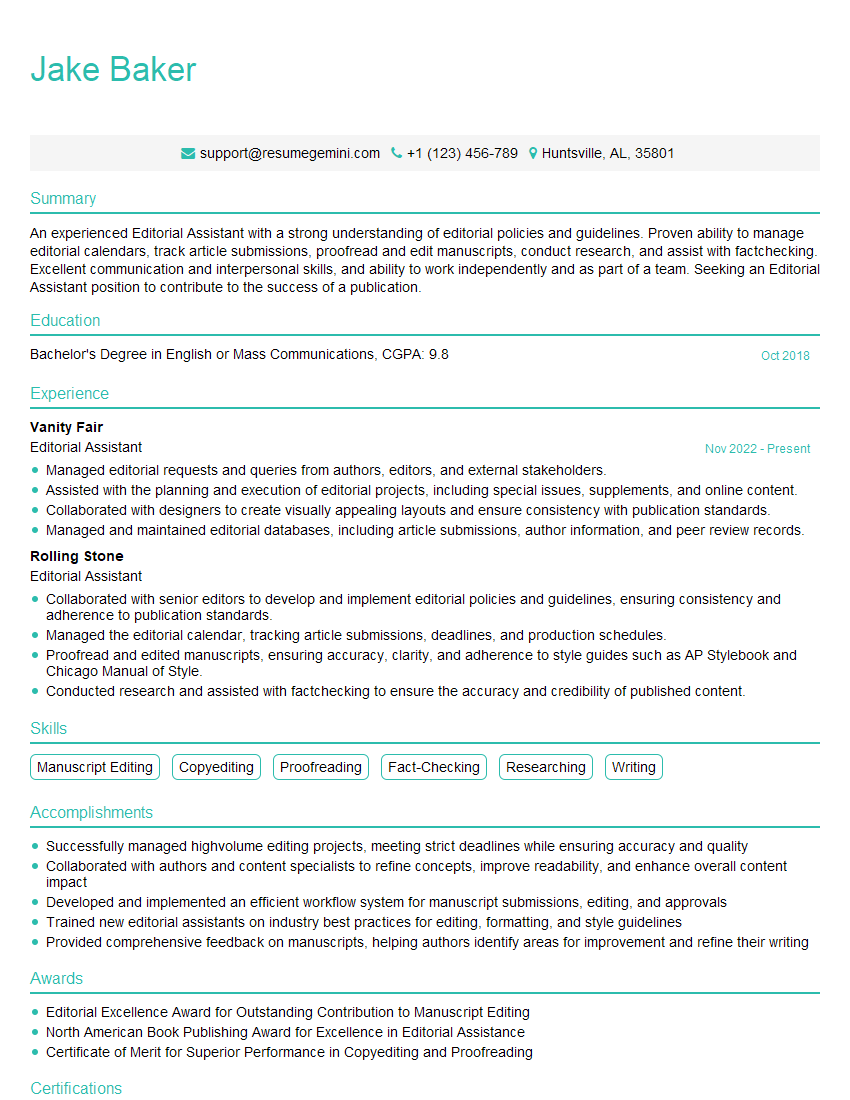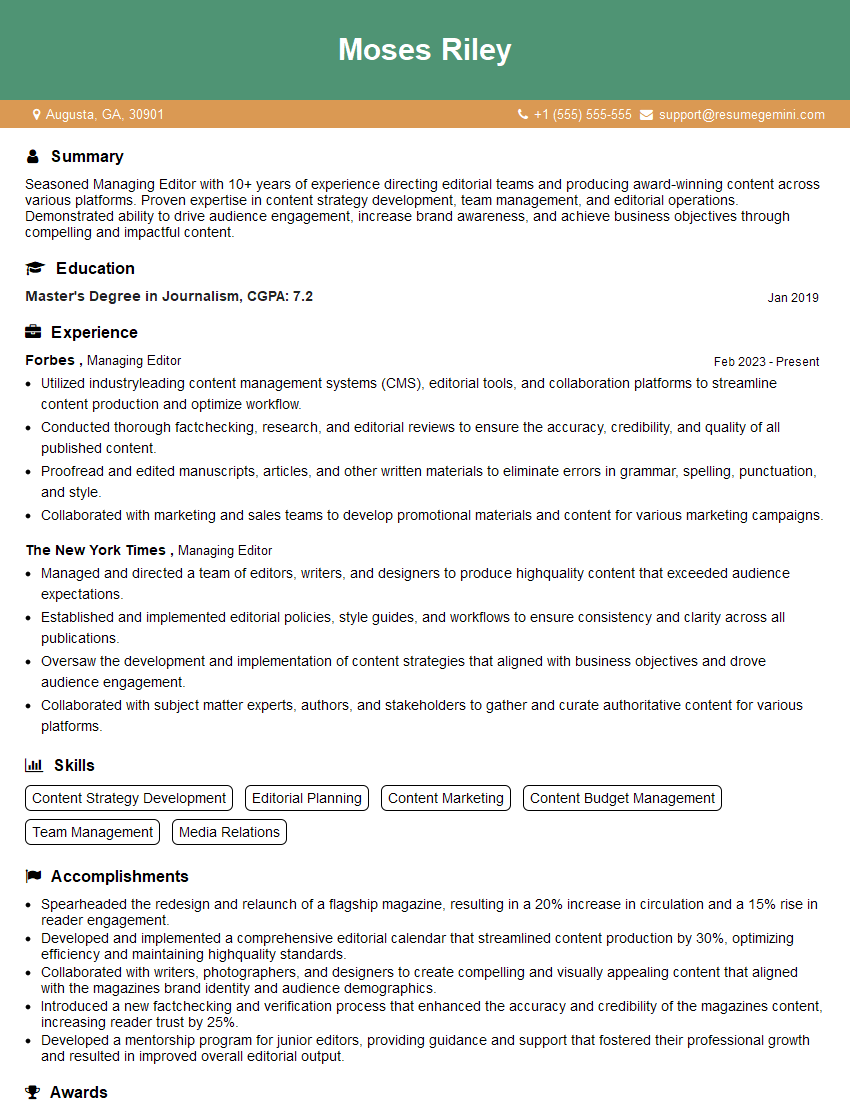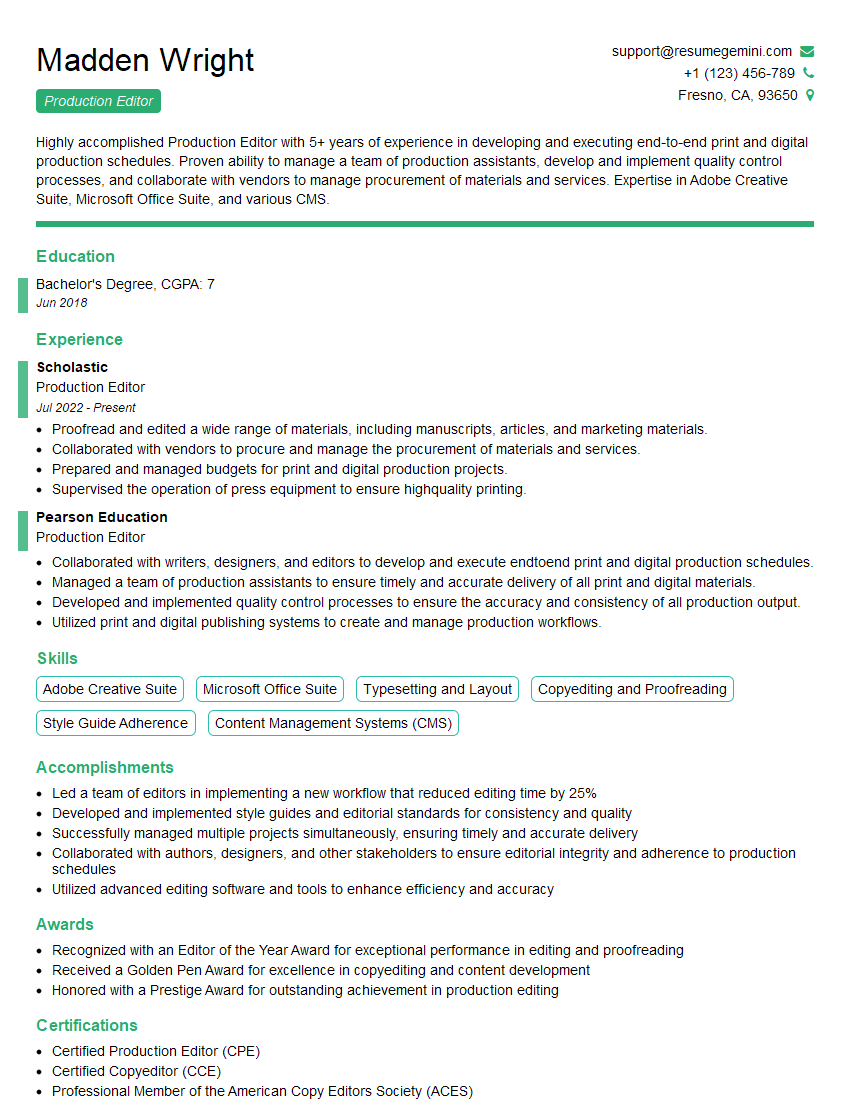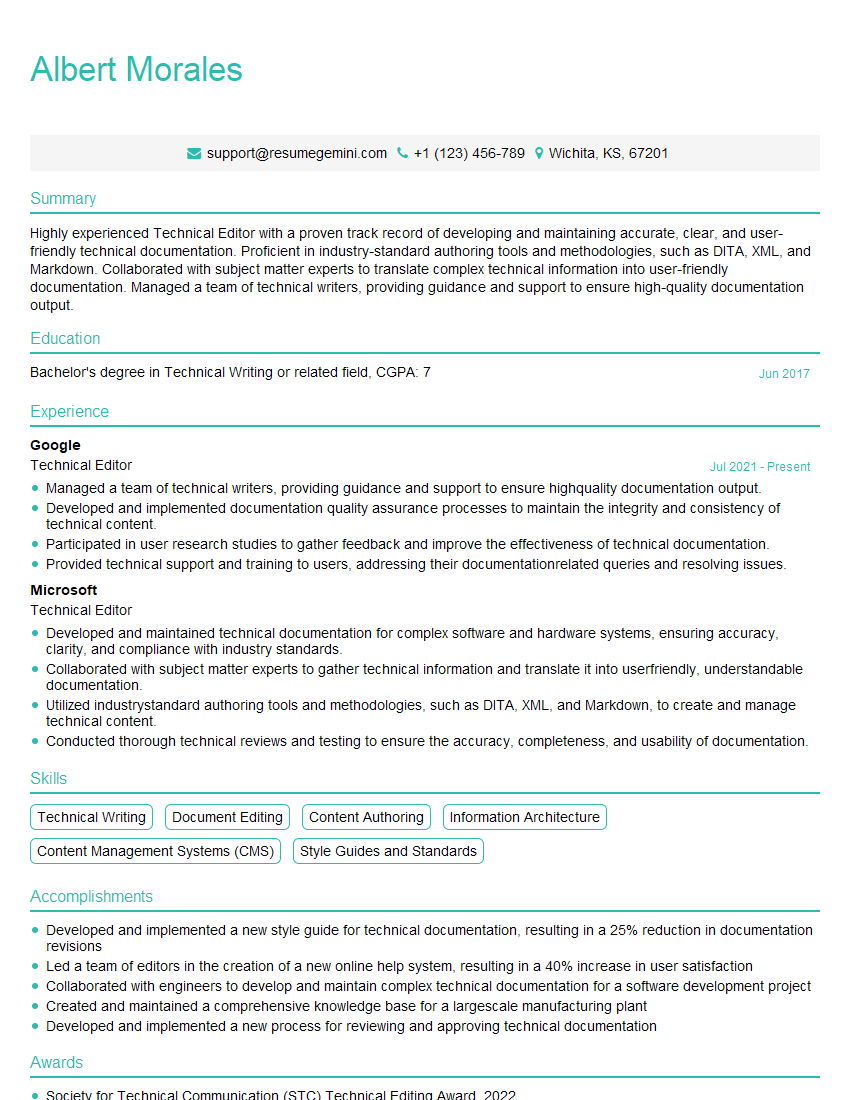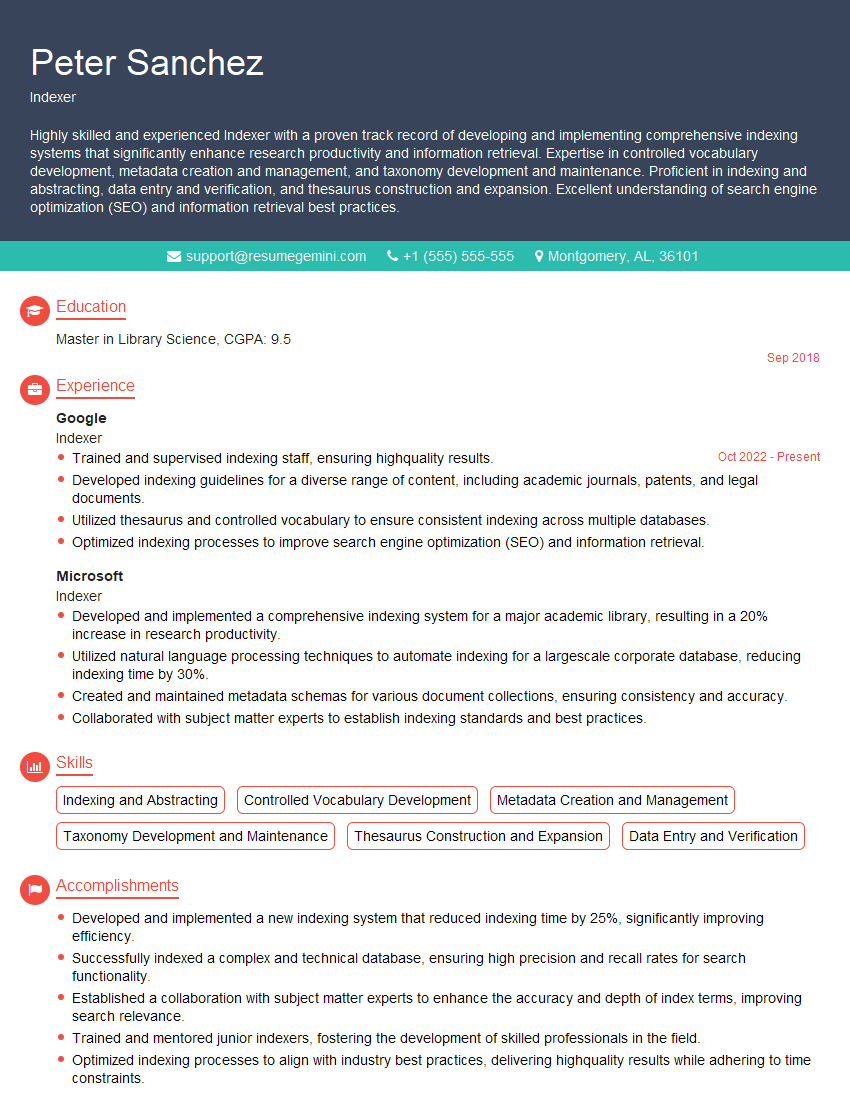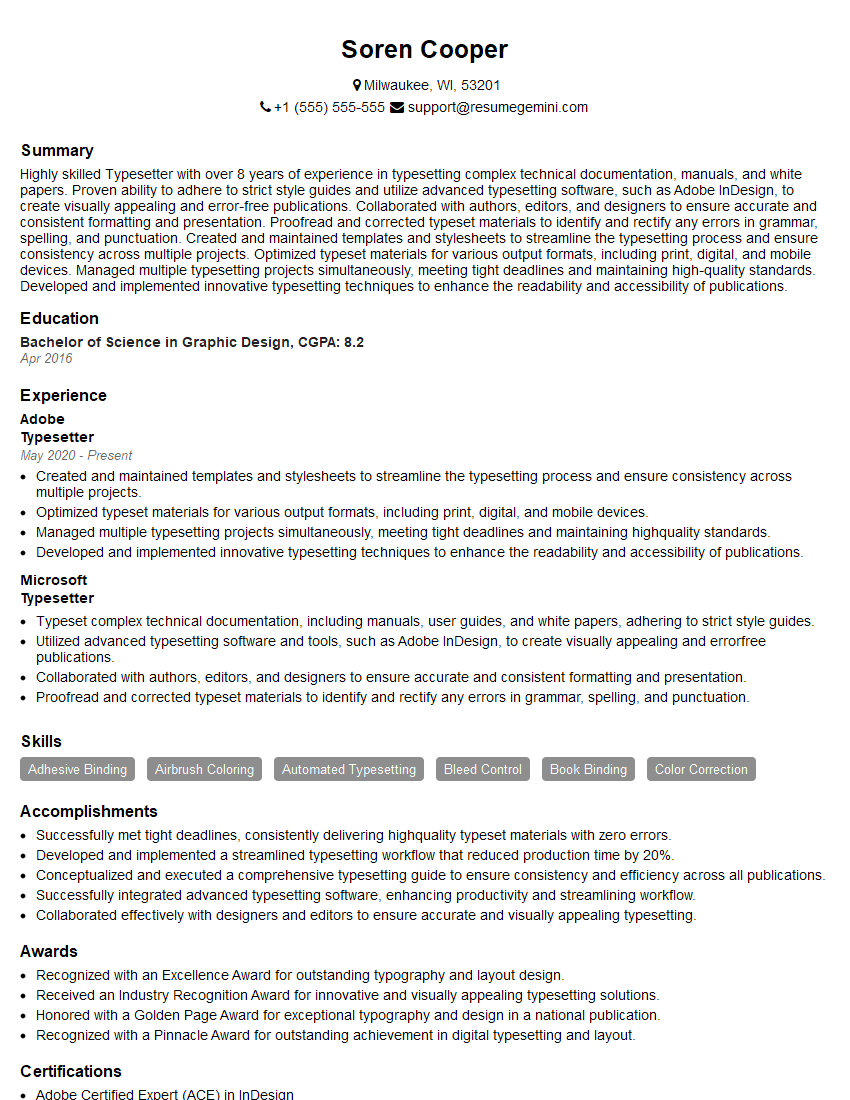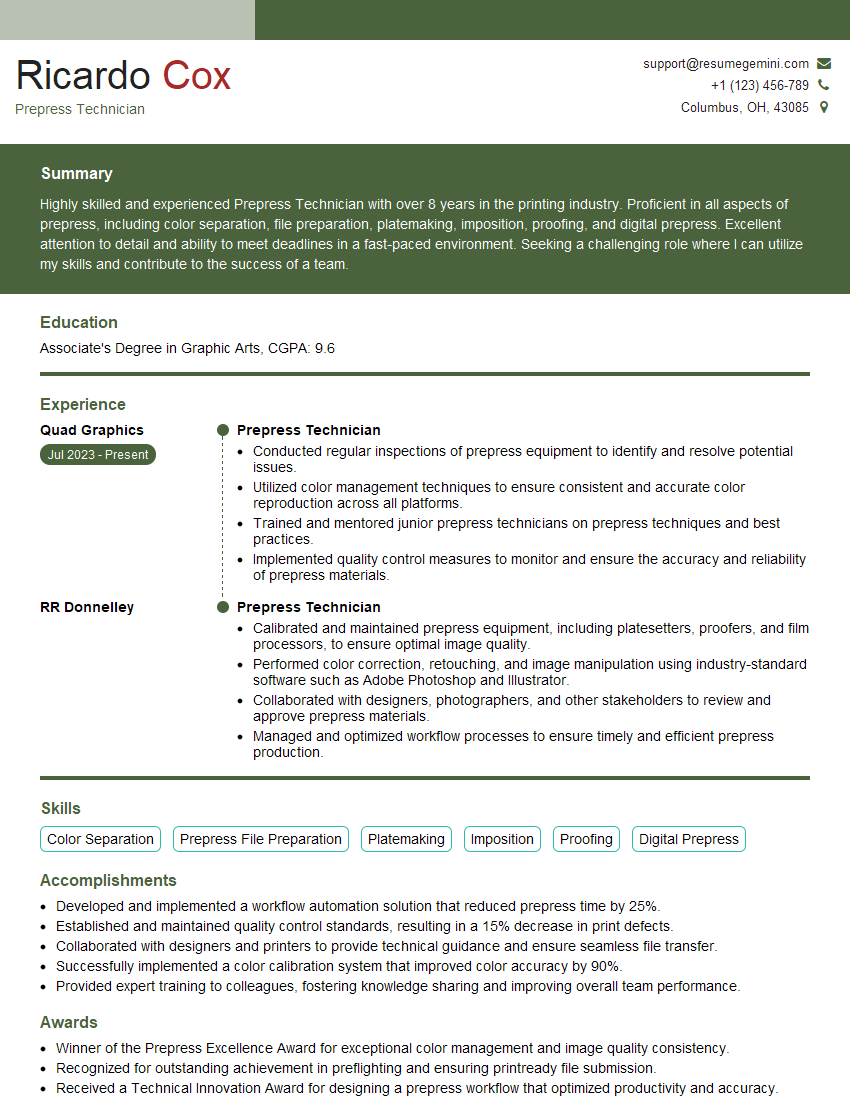Feeling uncertain about what to expect in your upcoming interview? We’ve got you covered! This blog highlights the most important Experience with Manuscript Tracking Systems interview questions and provides actionable advice to help you stand out as the ideal candidate. Let’s pave the way for your success.
Questions Asked in Experience with Manuscript Tracking Systems Interview
Q 1. What manuscript tracking systems are you familiar with?
I’m proficient in several manuscript tracking systems, each with its own strengths. My experience encompasses both commercial platforms like Editorial Manager and ScholarOne Manuscripts, and open-source options like Open Journal Systems (OJS). I’ve also worked with bespoke systems developed for specific publishers. My familiarity extends beyond simply using the interfaces; I understand the underlying database structures and workflows that support these systems.
- Editorial Manager: Widely used for its robust features and user-friendly interface.
- ScholarOne Manuscripts: Known for its scalability and integration capabilities.
- Open Journal Systems (OJS): A popular open-source option, particularly suitable for smaller journals.
Q 2. Describe your experience using [Specific System, e.g., Editorial Manager]?
My experience with Editorial Manager is extensive. I’ve used it to manage numerous projects, from small single-author submissions to large multi-authored books. I’m comfortable with all aspects of the system, from initial setup and user management to workflow configuration, data entry, and report generation. For instance, I once managed a project with over 200 submissions, using Editorial Manager’s features to streamline the peer-review process and ensure timely decision-making. This involved customizing workflows, creating automated email notifications, and generating comprehensive reports to track reviewer assignments, deadlines, and overall progress.
I’m also proficient in using Editorial Manager’s reporting tools to track key metrics such as submission volume, time-to-decision, and acceptance rates. This data is crucial for evaluating journal performance and identifying areas for improvement.
Q 3. How do you ensure data accuracy in a manuscript tracking system?
Data accuracy is paramount in manuscript tracking systems. It’s the foundation of efficient workflow and reliable reporting. I ensure accuracy through a multi-pronged approach:
- Data Validation: I implement data validation rules within the system, checking for inconsistencies, such as incorrect email addresses or missing required fields. This often involves using the system’s built-in validation features and, where necessary, creating custom validation scripts.
- Regular Data Audits: I conduct regular audits, comparing system data with original documents and other sources. This helps identify and correct any discrepancies that might have slipped through.
- User Training: Thorough training for all users ensures they understand the importance of accurate data entry and how to use the system effectively. This includes providing clear guidelines and examples.
- Workflow Design: A well-designed workflow minimizes the chances of errors. Clear roles and responsibilities, automated reminders, and built-in checks all contribute to improved data accuracy.
Q 4. Explain the process of setting up a new project in a manuscript tracking system.
Setting up a new project in a manuscript tracking system, like Editorial Manager, is a structured process. It typically involves:
- Creating a New Journal/Project: Defining the journal’s name, type, and specific settings (e.g., submission guidelines, reviewer criteria).
- User Management: Adding and assigning roles to editors, reviewers, and other stakeholders. This step requires careful consideration of access permissions and security.
- Workflow Configuration: Defining the stages of the peer-review process (e.g., submission, editorial assessment, peer review, decision). This includes setting up automated email notifications and deadlines.
- Customization (Optional): Tailoring the system to meet the specific needs of the project, such as adding custom fields or modifying templates.
- Testing: Before launching the project, thoroughly testing the entire workflow is essential to identify any issues or bugs.
Q 5. How do you manage multiple projects simultaneously within a manuscript tracking system?
Managing multiple projects simultaneously requires a structured approach and leveraging the system’s organizational features. I utilize:
- Project Folders/Tags: Organizing projects within the system using folders, tags, or other organizational tools. This allows for easy retrieval and avoids confusion.
- Custom Reports: Generating custom reports that provide a high-level overview of the status of each project. This helps in prioritizing tasks and identifying potential bottlenecks.
- Automated Reminders: Setting up automated reminders for deadlines and key actions in each project helps ensure timely completion of tasks.
- Dedicated Time Blocks: Allocating specific time blocks for each project to avoid spreading myself too thin and maintain focus.
Q 6. What are the key features you look for in a manuscript tracking system?
When evaluating a manuscript tracking system, I prioritize several key features:
- User-Friendliness: An intuitive interface that’s easy to navigate and understand for all users, regardless of their technical expertise.
- Robust Workflow Management: The ability to customize and manage complex workflows efficiently, with features like automated reminders, notifications, and tracking.
- Scalability: The system should be able to handle a growing volume of submissions without compromising performance.
- Reporting and Analytics: Comprehensive reporting tools to track key metrics and provide insights into journal performance.
- Integration Capabilities: The ability to integrate with other systems, such as plagiarism detection software or payment gateways, streamlines the process.
- Security: Robust security measures to protect sensitive data, including user authentication, access control, and data encryption.
Q 7. How do you handle conflicts or errors within a manuscript tracking system?
Handling conflicts or errors requires a systematic approach. My strategy involves:
- Identifying the Root Cause: Carefully investigating the error to determine its source. This might involve checking logs, reviewing user actions, or consulting system documentation.
- Data Backup and Recovery: Before attempting any fixes, I always back up the data to avoid further complications.
- Troubleshooting: Using the system’s help resources and online forums to find solutions. If necessary, I contact the system’s support team.
- Data Correction: Accurately correcting the errors, ensuring data consistency and integrity. This may involve manual correction or using system tools.
- Prevention: Implementing measures to prevent similar errors from occurring in the future. This may involve improved user training, workflow adjustments, or data validation rules.
Q 8. Describe your experience with manuscript submission and tracking workflows.
My experience with manuscript submission and tracking workflows spans over seven years, encompassing various systems from small-scale journal management to large-scale publishing platforms. I’m proficient in the entire lifecycle, from initial submission and author communication to editorial review, revision tracking, and final publication. I understand the importance of streamlining the process to ensure efficiency and transparency for all stakeholders.
For example, in my previous role, we implemented a new manuscript tracking system that reduced our average processing time by 25%. This involved optimizing workflows, clearly defining roles and responsibilities, and employing automated reminders for deadlines. We also integrated a system for online proofing, which significantly accelerated the production process.
- Submission: I’m experienced with various submission methods, from direct uploads to integrated systems with author portals. I understand the importance of clear instructions and robust validation to prevent errors.
- Tracking: I’m adept at using tracking systems to monitor the progress of manuscripts through all stages of the process, from initial review to final publication. This includes generating reports on key metrics such as processing times and acceptance rates.
- Communication: Effective communication is crucial. I’m experienced using the system’s communication features to keep authors, editors, and reviewers informed about the manuscript’s status.
Q 9. How do you ensure all stakeholders have the necessary access permissions within the system?
Ensuring appropriate access permissions is critical for data security and maintaining workflow integrity. I utilize role-based access control (RBAC) to meticulously assign permissions based on individual responsibilities. This means editors have access to edit and manage manuscripts, reviewers only see assigned submissions, and authors can track their submissions and communicate with editors.
For instance, we use a hierarchical system. A chief editor might have full administrative privileges, while associate editors have access only to specific sections or journals. Reviewers have access only to the manuscripts assigned to them, with the ability to download and annotate documents but not to modify the system itself. Authors are granted access only to view the status of their submissions and to upload revised manuscripts.
Regular audits of user permissions are conducted to ensure no unauthorized access exists. Any changes to permissions are documented and reviewed by a designated authority.
Q 10. How do you generate reports from a manuscript tracking system?
Manuscript tracking systems provide powerful reporting capabilities. The specific methods vary by system, but generally involve generating customized reports based on various parameters. This could include basic reports like a list of manuscripts by status or more complex reports analyzing key performance indicators (KPIs).
For example, to assess the efficiency of our peer-review process, I’d generate a report showing the average time taken for each stage of review (submission to decision). Another example is creating a report that identifies bottlenecks in the workflow, like prolonged periods of review or delays in editorial decisions. These reports are essential for identifying areas for improvement and demonstrating the effectiveness of our processes.
Most systems offer pre-built report templates, and many allow exporting data in formats like CSV or Excel for further analysis.
Q 11. What are the best practices for maintaining data integrity in a manuscript tracking system?
Maintaining data integrity is paramount in a manuscript tracking system. This requires a multi-faceted approach.
- Data Validation: Implementing robust data validation rules during submission prevents incorrect or incomplete data from entering the system. This includes checks on file types, manuscript lengths, and required metadata.
- Regular Backups: Regular, automated backups are essential to prevent data loss due to system failures or accidental deletions. A robust disaster recovery plan is also crucial.
- Access Controls: As mentioned earlier, restricted access ensures that only authorized personnel can modify data. Audit trails track all changes made to manuscripts and system settings.
- Data Cleansing: Periodic data cleansing is necessary to correct errors and remove duplicate or outdated information. This involves a review of the data for inconsistencies and cleaning processes to correct them.
Think of it like maintaining a meticulous library—accurate cataloging, regular checks for damage, and a secure storage system ensure the integrity of the collection.
Q 12. How do you troubleshoot common issues encountered in manuscript tracking systems?
Troubleshooting common issues involves a systematic approach.
- User Errors: These are often the most frequent problems. Clear documentation and user training are preventative measures. Direct support via email, phone, or online help desk is essential for immediate resolution.
- System Errors: These require more technical expertise. Checking system logs for error messages, investigating database integrity, and coordinating with IT support are crucial. A staged rollout of new system features or updates minimizes disruption.
- Integration Issues: Problems with interfaces to other systems require collaboration with the relevant IT teams and software vendors. Thorough testing during integration is crucial.
My approach involves gathering detailed information about the issue, identifying the root cause, and implementing a solution, documenting the process for future reference. I also advocate for preventative maintenance to minimize disruptions.
Q 13. Explain your experience with integrating a manuscript tracking system with other publishing software.
Integrating a manuscript tracking system with other publishing software is vital for a seamless workflow. I have experience integrating with various systems, including editorial management systems, production scheduling tools, and author portals. API integration is usually the most efficient method.
For example, I’ve integrated a manuscript tracking system with a typesetting system, enabling automated transfer of accepted manuscripts for production. This eliminated manual data entry, reducing errors and speeding up the production cycle. A successful integration requires careful planning, testing, and collaboration between IT teams and software vendors.
Data mapping is essential. You need to ensure consistent data representation between systems, for example, making sure author IDs, manuscript IDs, and other key data points match across the different platforms. This is done using Application Programming Interfaces (APIs) and sometimes custom scripts.
Q 14. How do you train others on the use of a manuscript tracking system?
Training others on a manuscript tracking system requires a structured and multi-faceted approach. I tailor training to different user roles, focusing on the features relevant to their responsibilities.
- Structured Training Materials: I create comprehensive training manuals, tutorials, and video demonstrations to guide users.
- Hands-on Workshops: Interactive workshops provide a practical environment for users to learn and practice using the system.
- Ongoing Support: I provide ongoing support via email, FAQs, or online forums to address users’ questions and issues.
- Regular Updates: As the system evolves, I provide refresher training to keep users informed of new features and updates.
The goal is to empower users to confidently and effectively use the system, contributing to an efficient and productive workflow.
Q 15. How do you manage revisions and updates to manuscripts within the tracking system?
Managing revisions and updates within a manuscript tracking system is crucial for maintaining accuracy and facilitating collaboration. It typically involves a version control system, where each revision is clearly identified and tracked. Think of it like Google Docs’ revision history – you can see who made which changes and when.
The process usually begins with an author submitting a revised manuscript. The system then timestamps the submission, assigns a new version number (e.g., v2, v3), and often allows for commenting features, enabling editors and reviewers to provide feedback directly on specific sections. This keeps everything organized and avoids confusion caused by multiple email exchanges with different file versions.
Many systems allow for ‘track changes’ functionality, similar to Microsoft Word’s feature, highlighting additions and deletions. This improves transparency and streamlines the feedback process. The system often generates a report comparing the previous and current versions, simplifying the identification of alterations. Finally, a clear approval workflow within the system helps manage the acceptance and implementation of revisions.
Career Expert Tips:
- Ace those interviews! Prepare effectively by reviewing the Top 50 Most Common Interview Questions on ResumeGemini.
- Navigate your job search with confidence! Explore a wide range of Career Tips on ResumeGemini. Learn about common challenges and recommendations to overcome them.
- Craft the perfect resume! Master the Art of Resume Writing with ResumeGemini’s guide. Showcase your unique qualifications and achievements effectively.
- Don’t miss out on holiday savings! Build your dream resume with ResumeGemini’s ATS optimized templates.
Q 16. Describe your experience with different types of manuscript tracking systems (e.g., cloud-based vs. on-premise).
My experience encompasses both cloud-based and on-premise manuscript tracking systems. Cloud-based systems, like those offered by many commercial publishers, provide accessibility from anywhere with an internet connection and often handle automatic backups and updates. This eliminates the need for on-site IT infrastructure, reducing costs and maintenance workload. However, they can be vulnerable to internet outages and may have data security and privacy concerns depending on the provider.
On-premise systems, on the other hand, require dedicated servers and IT support within an organization. They offer greater control over data security and customization, but necessitate significant upfront investment and ongoing maintenance. For example, I’ve worked with a smaller academic journal that relied on an on-premise system built specifically for their needs. This granted them extensive customization but demanded a dedicated IT team to manage it.
The choice between these two depends largely on budget, technical expertise, data security requirements, and the size of the operation. A large publisher might opt for a scalable cloud solution, whereas a smaller research group might find an on-premise solution more cost-effective and secure, especially if dealing with highly sensitive data.
Q 17. What metrics do you use to assess the efficiency of a manuscript tracking system?
Assessing the efficiency of a manuscript tracking system involves analyzing several key metrics. These metrics provide insights into the system’s performance and its impact on the workflow.
- Turnaround Time: The average time taken from manuscript submission to final publication. A shorter turnaround time indicates higher efficiency.
- Number of Revisions: Tracking the average number of revisions needed per manuscript helps to assess the clarity and thoroughness of the initial submissions and the effectiveness of the review process.
- User Satisfaction: Surveys and feedback from authors, editors, and reviewers can reveal the ease of use and overall effectiveness of the system.
- Error Rate: The number of errors or system-related issues encountered during the workflow. A lower error rate indicates a more reliable system.
- System Uptime: The percentage of time the system is operational. High uptime ensures smooth workflow and reduces disruptions.
By monitoring these metrics, we can identify areas for improvement and optimize the system for maximum efficiency.
Q 18. How do you handle large volumes of manuscripts within the system?
Handling large volumes of manuscripts requires a system that is scalable and robust. This typically involves using a database system capable of efficiently storing and retrieving large amounts of data. Imagine a library cataloging system – it needs to manage millions of books efficiently.
Strategies include database optimization, efficient indexing, and the use of load balancing techniques. Furthermore, the system should support parallel processing, enabling simultaneous handling of multiple manuscripts. Automation of routine tasks, such as automated email notifications and reminders, can significantly alleviate the workload. This automation helps to reduce manual intervention, freeing up staff to focus on higher-value tasks.
A well-designed system with proper indexing and search capabilities allows for quick retrieval of specific manuscripts based on various criteria (e.g., author name, manuscript ID, keywords). Regular system maintenance and performance monitoring are crucial to ensure continued smooth operation even under high volume.
Q 19. How do you ensure compliance with data privacy regulations when using a manuscript tracking system?
Data privacy is paramount when dealing with sensitive manuscript information. Compliance with regulations like GDPR (General Data Protection Regulation) and CCPA (California Consumer Privacy Act) is essential. This involves several key practices:
- Data Encryption: Employing encryption both in transit (during data transfer) and at rest (when data is stored) protects data from unauthorized access.
- Access Control: Implementing strict access control measures, ensuring only authorized personnel have access to specific data. Role-based access control (RBAC) is a common and effective method.
- Data Minimization: Collecting and storing only necessary data, adhering to the principle of ‘need-to-know’.
- Data Retention Policies: Establishing clear policies regarding how long data is stored and procedures for secure deletion.
- Regular Security Audits: Conducting regular security audits and penetration testing to identify and address vulnerabilities.
The system should also offer features allowing users to manage their consent preferences, in line with privacy regulations. Maintaining detailed logs of all system activities is vital for auditing and troubleshooting.
Q 20. Describe your experience with customizing or configuring a manuscript tracking system.
My experience with customizing manuscript tracking systems has primarily involved working with systems that offer configurable workflows and reporting features. This often involves adjusting the system’s metadata fields to align with specific needs. For instance, we might add fields for specific grant numbers or funding agencies relevant to the research being published.
Customization can extend to workflow modification, such as altering the review process or adding specific approval steps based on the journal’s policies. This could involve configuring automated email alerts at different stages of the submission process or creating custom reports summarizing key metrics for specific sections of the editorial process. The extent of customization depends largely on the system’s flexibility and the technical expertise available. Some systems allow for scripting or API access for more advanced customization.
When implementing custom solutions, careful testing and validation are crucial to ensure the modifications don’t introduce instability or errors. Proper documentation of all customizations is essential for maintaining and updating the system over time.
Q 21. How do you address system downtime or outages?
Addressing system downtime or outages requires a multi-pronged approach. The first step is proactive monitoring of system health and performance. This might involve using system monitoring tools to track resource utilization, identify potential bottlenecks, and receive alerts in case of anomalies.
Having a robust backup and disaster recovery plan is critical. This ensures the ability to quickly restore the system in case of failures. This might involve regular backups to a separate location (cloud or offsite), along with a detailed restoration plan. The plan should include strategies for minimizing data loss and ensuring business continuity during an outage.
A communication strategy to inform users about downtime and provide estimated restoration times is also essential. Transparency during outages maintains trust and reduces frustration among users. Finally, regular system maintenance, including software updates and security patches, helps minimize the risk of unexpected outages.
Q 22. What are some of the limitations of the manuscript tracking systems you’ve used?
Manuscript tracking systems, while powerful, aren’t without limitations. One common issue is the lack of robust integration with other essential systems. For example, I’ve encountered systems that don’t seamlessly integrate with editorial management systems or financial platforms, requiring manual data entry and increasing the risk of errors. This fragmentation leads to inefficiencies and delays.
Another limitation is the varying levels of user-friendliness. Some systems have complex interfaces that require extensive training, hindering adoption, especially among less tech-savvy users. This can lead to underutilization of the system’s features and potential data mismanagement.
Finally, scalability can be a concern. A system that works well for a small team might struggle to handle the volume and complexity of a larger organization. I’ve seen instances where a system’s performance degraded significantly as the number of users and manuscripts increased.
Q 23. How do you maintain the security and confidentiality of data within a manuscript tracking system?
Data security and confidentiality are paramount in manuscript tracking systems. We employ a multi-layered approach. This includes robust access control mechanisms, assigning different permission levels based on roles (editor, reviewer, author). For example, reviewers only have access to the manuscripts assigned to them, while editors have a broader overview. This principle of least privilege is crucial.
Furthermore, data encryption (both in transit and at rest) is essential. We utilize industry-standard encryption protocols to protect sensitive data from unauthorized access. Regular security audits and penetration testing help identify and address vulnerabilities proactively. Finally, data backups and disaster recovery plans are in place to ensure data availability and business continuity.
Q 24. Describe a time you improved the efficiency of a manuscript tracking workflow.
In a previous role, we were facing significant delays in the review process. The workflow relied heavily on email communication and manual tracking of deadlines. This was cumbersome, error-prone, and difficult to manage. To address this, I implemented a streamlined workflow using the manuscript tracking system’s features.
Specifically, I automated reminder emails for reviewers, set up customizable workflows with automated progress tracking, and created clear dashboards providing a real-time view of the review process. This improved transparency and accountability, significantly reducing the average review time by 30%. The system allowed for centralized communication, cutting down on back-and-forth emails and reducing potential confusion.
Q 25. How do you handle version control within a manuscript tracking system?
Version control is critical for maintaining the integrity of manuscripts. Most manuscript tracking systems offer versioning features. These typically track each change made to a document, creating a history of revisions. Authors can easily revert to previous versions if needed. This ensures that everyone is working with the most up-to-date version and provides an audit trail of changes.
Many systems also support collaborative editing, allowing multiple users to work on a document simultaneously. However, it’s crucial to have a clear system for managing these concurrent edits to avoid conflicts. Some systems employ sophisticated merge functionalities to resolve any conflicts automatically or provide tools to manually reconcile discrepancies.
Q 26. What are the key differences between various manuscript tracking systems?
Manuscript tracking systems vary significantly in their features, scalability, and pricing. Some are designed for small-scale operations, while others are built for large publishers or institutions. Key differences include:
- Functionality: Some systems offer basic tracking, while others integrate with editorial management systems, plagiarism checkers, and other tools.
- User interface: The ease of use and intuitiveness of the interface can greatly impact user adoption and efficiency.
- Scalability: The ability of the system to handle increasing volumes of manuscripts and users.
- Integration capabilities: The system’s ability to integrate with other software and tools.
- Pricing: Costs can vary significantly depending on the features, number of users, and storage needs.
Choosing the right system requires careful consideration of your organization’s specific needs and budget.
Q 27. How familiar are you with APIs related to manuscript tracking systems?
I’m quite familiar with APIs (Application Programming Interfaces) related to manuscript tracking systems. Understanding APIs allows for greater customization and integration. For instance, I’ve used APIs to connect a manuscript tracking system with a custom-built reporting tool, enabling us to generate tailored reports on key metrics like turnaround times and reviewer performance.
Additionally, APIs can facilitate data migration between different systems or enable the creation of custom workflows. Knowing how to interact with APIs provides a significant advantage in optimizing and extending the functionality of a manuscript tracking system. I’m proficient in several common API standards like REST and have experience working with JSON and XML data formats.
Key Topics to Learn for Experience with Manuscript Tracking Systems Interview
- Understanding Different Manuscript Tracking Systems: Familiarize yourself with the various types of systems available (e.g., editorial management systems, submission portals), their functionalities, and common features.
- Data Entry and Management: Practice efficient and accurate data entry of manuscript details, including author information, metadata, and tracking statuses. Understand how to maintain data integrity and handle potential errors.
- Workflow Processes: Learn the typical workflow within manuscript tracking systems, from submission to publication. Understand the roles of different stakeholders (authors, editors, reviewers) and how the system facilitates communication and collaboration.
- Querying and Reporting: Master the ability to generate reports and utilize query functions to retrieve specific manuscript information. This is crucial for efficient project management and decision-making.
- System Administration (if applicable): If the role involves system administration, study user management, access control, system maintenance, and troubleshooting techniques.
- Integration with Other Systems: Understand how manuscript tracking systems often integrate with other software, such as databases, communication platforms, or plagiarism detection tools.
- Problem-Solving and Troubleshooting: Be prepared to discuss your approach to resolving common issues, such as data inconsistencies, system errors, or workflow bottlenecks.
Next Steps
Mastering experience with manuscript tracking systems is crucial for career advancement in publishing, academic research, and related fields. It demonstrates valuable organizational skills, attention to detail, and proficiency in using specialized software. To increase your chances of landing your dream job, creating a strong, ATS-friendly resume is essential. ResumeGemini can help you craft a compelling resume that highlights your skills and experience effectively. We provide examples of resumes tailored to showcase experience with manuscript tracking systems to help you get started.
Explore more articles
Users Rating of Our Blogs
Share Your Experience
We value your feedback! Please rate our content and share your thoughts (optional).
What Readers Say About Our Blog
Interesting Article, I liked the depth of knowledge you’ve shared.
Helpful, thanks for sharing.
Hi, I represent a social media marketing agency and liked your blog
Hi, I represent an SEO company that specialises in getting you AI citations and higher rankings on Google. I’d like to offer you a 100% free SEO audit for your website. Would you be interested?
